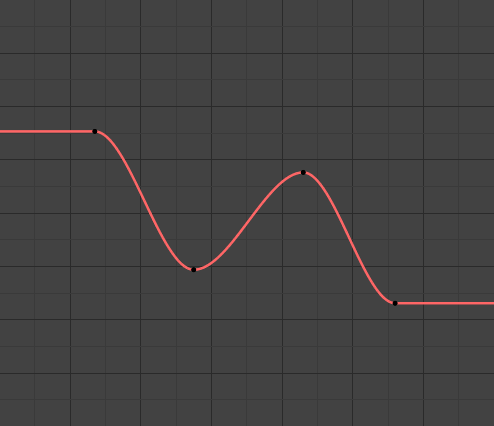Editing
Delete Channels
Reference
- Menu:
- Atalho:
X
Deletes the whole channel from the current action (i.e. unlink the underlying F-Curve data-block from this action data-block).
Aviso
O atalho X é dependente de área. Caso você o utilize na parte esquerda da lista, ele irá apagar os canais selecionados, e caso você o utilize na área principal, ele irá apagar os quadros-chave selecionados.
Un/Group Channels
Reference
- Menu:
- Atalho:
Ctrl-Alt-G, Ctrl-G
Un/Groups the selected channels into a collection that can be renamed by double clicking on the group name. For example, this helps to group channels that relate a part of an armature to keep the editor more organized.
Toggle/Enable/Disable Channel Settings
Reference
- Menu:
- Atalho:
Shift-W, Shift-Ctrl-W, Alt-W
Enable/disable a channel’s setting (selected in the menu that pops up).
- Protect, Mute
A ser feito.
Toggle Channel Editability
Reference
- Menu:
- Atalho:
Atalho: Tab
Bloqueia ou desbloqueia um canal para edição.
Extrapolation Mode
Reference
- Menu:
- Atalho:
Shift-E
Change the extrapolation between selected keyframes.
Extrapolation defines the behavior of a curve before the first and after the last keyframes.
There are two basic extrapolation modes:
- Constante:

Extrapolação constante.
The default one, curves before their first keyframe and after their last one have a constant value (the one of these first and last keyframes).
- Linear:

Extrapolação linear.
Curves ends are straight lines (linear), as defined by the slope of their first and last keyframes.
Additional extrapolation methods (e.g. the Cycles modifier) are located in the F-Curve Modifiers.
Add F-Curve Modifier
Reference
- Menu:
- Atalho:
Shift-Ctrl-M
Opens a pop-up allowing you to add modifiers to the active F-Curve. Settings for the modifier can be found in the tab.
Mostrar ou ocultar
- Oculta as curvas selecionadas.
Oculta as curvas selecionadas.
- Hide Unselected Shift-H
Show only the selected curve (and hide everything else).
- Gerar curvas Alt-C
Show all previous hidden curves.
Expand/Collapse Channels
Reference
- Menu:
- Atalho:
NumpadPlus, NumpadMinus
Expande ou recolhe os canais selecionados.
Mover
Reference
- Menu:
This allows you to move selected channels up/down PageUp, PageDown, or directly to the top/bottom Shift-PageUp, Shift-PageDown.
Reviver as curvas-f desabilitadas
Reference
- Menu:
Clears «disabled» tag from all F-Curves to get broken F-Curves working again.
Frame Selected Channels
Reference
- Menu:
- Atalho:
Tecl. Num. vírgula
Reset viewable area to show the selected channels. To frame the channel that is under the mouse cursor, use Alt-MMB.
- Include Handles
Include handles of keyframes when calculating extents.
- Use Preview Range
Ignore frames outside of the preview range.
Keys to Samples
Reference
- Menu:
- Atalho:
Alt-C
This operator replaces an F-Curve with a set of sampled points at each full frame. It is a destructive process that removes the ability to edit the curve. The main use for this is to reduce the file size with large datasets. Samples are only 1/5th the size per key. The sampled points interpolate linearly on subframes.
Samples to Keys
Reference
- Menu:
This operator replaces a sampled F-Curve with keyframes, adding the ability to edit it. It will not recreate the curve as it was before, instead it will place 1 key at every frame.
Sound to Samples
Reference
- Menu:
The Sound to Samples operator takes a sound file and uses its sound wave to create the animation data. By default this data will not be editable, use Samples to Keys to get editable keyframes.
- Lowest Frequency
Frequência de corte de um filtro passa-alta que é aplicada aos dados de áudio.
- Highest Frequency
Frequência de corte de um filtro passa-baixa que é aplicada aos dados de áudio.
- Attack Time
Valor para calculação da curva do casco que diz quão rápido a curva do casco pode levantar. Quanto mais baixo o valor, mais íngreme ela irá subir.
- Release Time
Valor para a calculação da curva do casco que mostra quão rápido a curva do casco pode cair. Quanto mais baixo o valor, mais difícil ele pode cair.
- Ajuste
Valor de amplitude mínima necessária para influenciar a curva do casco.
- Acumular
Somente as diferenças positivas de amplitude da curva do casco são sumarizadas para produzir a saída.
- Aditivo
As amplitudes da curva convexa são sumarizadas (ou, quando «Acumular» está habilitado, ambas as diferenças positivas e negativas são acumuladas).
- Square
Gives the output as a square curve. Negative values always result in -1, and positive ones in 1.
- Ajuste de quadrado
All values lower than this threshold result in 0.
Discontinuity (Euler) Filter
Reference
- Menu:
A ser feito.